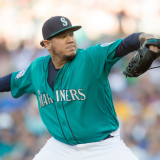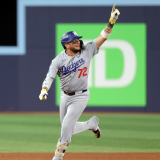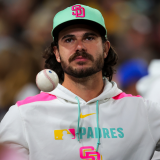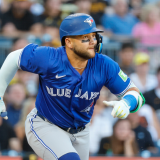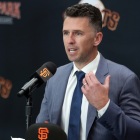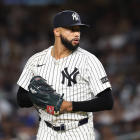
Oakland Athletics top prospect list 2020: Jesus Luzardo, A.J. Puk and Sean Murphy provide instant help
The A's have a number of prospects who should be on their Opening Day roster
With the regular season concluding, we've decided to take a look at each team's future -- not by using a crystal ball or other psychic abilities, but by evaluating their farm systems. Below you'll find our ranking of the top five prospects in the organization -- sorted by perceived future potential -- as well as five other players who fit various categories. Those categories are:
2020 contributor: A player who is likely to play a role for the big-league team next season.
Analyst's pick: A player who is a strong statistical performer and/or whose underlying measures are better than the scouting reports suggest.
Riser: A player on the way up.
Faller: A player on the way down.
One to watch: An interesting player to keep in mind (for whatever reason).
These rankings were compiled after talking with various industry sources about the systems (and players) in question. It should be acknowledged that this process is more art than science, and that there are limits to ordinal rankings. Still, it's an intuitive system, and our hope is that the write-ups will answer any questions by providing additional context and analysis of each player -- such as their pluses and minuses; the risk factors involved; and their estimated arrival date.
One last word on eligibility: we're following MLB's rookie guidelines by disqualifying any player with more than 130 big-league at-bats or 50 innings pitched.
A number of Oakland's top prospects have already played in the majors, and are positioned to make the 2020 roster.
1. Jesus Luzardo, LHP
Each of the top three prospects in the system made their big-league debut in 2019. Obviously that includes lefty Jesus Luzardo, who the Athletics originally acquired as part of the Sean Doolittle trade. (Blake Treinen and Ryan Madson were also involved.)
Luzardo, 22 since September, remains an availability question mark. Injuries limited him to 17 appearances in 2019, the second-most of his career. That Luzardo is the shorter side -- he's listed at 6-foot, 209 pounds -- isn't likely to convince anyone he can hold up to the rigors of a normal starter's workload.
Yet Luzardo has three above-average average pitches -- a mid-90s fastball, curveball, and changeup -- as well as feel for the craft and for throwing quality strikes. Those are the kinds of innate characteristics that tend to be present in above-average starters.
As such, a healthy Luzardo should break camp in the A's rotation. He's likely to remain there until his body or his paycheck demand otherwise.
2. A.J. Puk, LHP
The sixth pick in the 2016 draft, southpaw A.J. Puk took a touch longer than expected to crack the major-league roster.
Puk was viewed as the rotation's potential savior entering the 2018 season, yet missed the year due to Tommy John surgery. The A's took it slow and low with him in his return this season, limiting him to 28 games and 36 innings between the minors and majors, including 10 such appearances as part of the club's late-season bullpen.
During that big-league cameo, Puk relied heavily on his two best pitches: an upper-90s fastball and a swing-and-miss slider. Both of those offerings are plus or better. The rest of his arsenal -- he throws a 90-mph changeup and a curveball -- didn't receive as much praise, and he struggles with command the way more tall pitchers do (he's 6-foot-7).
There's a chance Puk becomes a No. 2 starter behind his fastball-slider. There's also a chance he's more of an inconsistent mid-rotation type, or even a shutdown reliever. The A's figure to give him every opportunity to become one of the first two, beginning early in 2020.
3. Sean Murphy, C
The Athletics haven't drafted and developed a catcher of note (who remained behind the plate, anyway) since Kurt Suzuki. Sean Murphy stands to change that.
Murphy's calling card is his defense. He combines a strong arm with solid receiving abilities and quality staff-handling, giving him a high floor. He isn't a zero at the plate, either. Rather, Murphy has always drawn walks -- and he has above-average power potential.
It's to be determined if Murphy leans into his power -- perhaps at the expense of his contact skills. But he has a chance to be a two-way contributor at a position without many.
4. Sheldon Neuse, 3B
Sheldon Neuse tends to get overlooked in the A's system for a few obvious reasons, beginning with the fact that he's a third baseman in an organization that already employs Matt Chapman at one corner. Add in Matt Olson at the other corner and Khris Davis at DH and Neuse appears likely to be moved this winter as part of a trade.
Whomever acquires Neuse will be getting a ready-made starter at the hot corner.
Neuse has a strong arm and a steady glove, and boasts average offensive potential. He's not going to emulate Chapman or anything, but he's shown some willingness to walk and an ability to hit for both: some average and power. He has had strikeout issues in the past, and it's at least worth considering the potential they balloon against big-league pitching.
Until that scenario comes to pass, Neuse feels like an average third baseman. There are worse fates.
5. Logan Davidson, SS
The 29th pick in the draft, Logan Davidson is a tall, switch-hitting shortstop who should be able to handle the position for the long haul.
The reason Davidson was around so late into the draft, then, has to do with his bat -- specifically the hit tool, the most important of them all. He's prone to swinging and missing at levels that makes teams weary, and speaks to a deficiency that could prevent him from tapping into his raw power with enough frequency to maximize his upside.
The key statistic for Davidson is going to be his strikeout rate. He fanned in more than 23 percent of his plate appearances in Low-A, so keep that in mind heading forward.
2020 contributor: Jorge Mateo, UTL
Originally acquired as part of the Sonny Gray trade, Jorge Mateo has had an up-and-down career. He was up again in 2019, nearly posting his first 20-20 season while hitting .289/.330/.504 at Triple-A. (Do note that Oakland's Triple-A affiliate had an OPS over .900 as a team.) Mateo's approach is likely to yield some ugly walk-to-strikeout ratios in the majors, putting pressure on his ability to leverage his top-of-the-scale speed into hustle extra-base hits. He's out of options and will presumably open the season on someone's bench. (Insert your own joke here about "someone" being the Kansas City Royals.)
Analyst's pick: Nick Allen, SS
There's no doubting Nick Allen's ability to play shortstop. He has the hands, the arm, the range, the preternatural feel for the position, and so on. What's to be determined is whether he has the bat to be more than a bench type. Allen had his best offensive season as a professional in 2019, and another like it in 2020 will land him in the top five.
Riser: Daulton Jefferies, RHP
Entering the season, Daulton Jefferies had thrown just 20 professional innings in two-plus years since being drafted 37th overall. The A's, predictably, took it slow with him as he returned from Tommy John surgery. For the most part, Jefferies was limited to three-inning outings throughout the year, resulting in 79 innings across two levels. He figures to have a longer leash in 2020. Provided Jefferies can stay healthy -- and hey, who knows -- he could debut in the Show as a back-end starter before the year is out.
Faller: Lazaro Armenteros, OF
Lazaro Armenteros is just 20 years old, but he's also a left fielder who struck out in 42 percent of his plate appearances in High-A. That doesn't bode well for his chances of making it to the majors. Age remains on his side, so if he can come to make more consistent contact then it'll be time to revisit his outlook.
One to watch: Robert Puason, SS
The Athletics signed teenage shortstop Robert Puason out of the Dominican Republic for more than $5 million. Puasson is an angular switch-hitter with good wheels and a strong arm. He turned 17 in September, so he's years away from being a finished product.


